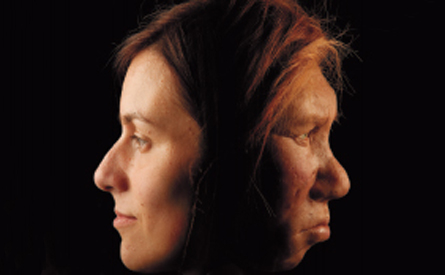2010 Science News of the Year: Genes & Cells

Credit: © Joe McNally/reconstruction by Kennis and Kennis
Gene sequencing for all, even Neandertals
An unprecedented picture of life’s diversity is emerging as researchers publish the full genetic instruction books of a growing list of species — including one that has been extinct for more than 30,000 years.
A project sequencing Neandertal DNA harvested from bones reveals evidence of prehistoric interbreeding between humans and Neandertals (SN: 6/5/10, p. 5). As for modern humans, scientists have compiled complete genetic profiles of Archbishop Desmond Tutu and a Bushman tribal elder named !Gubi (SN: 3/13/10, p. 16). Full genomes are also available for the first time for people of African-American, Mexican-American (SN: 7/3/10, p. 13), Japanese and Irish descent.
In addition, the pilot phase of the 1000 Genomes project has unveiled millions of genetic variants in about 800 people of several different ethnic origins (SN: 11/20/10, p. 14). This snapshot reveals that the average person carries defective copies of 250 to 300 genes, plus about 75 DNA variants associated with disease. Similar advances in DNA sequencing are also allowing researchers to decode the genomes of more species (See March of genomes).
Now scientists are looking for ways to put all this information to use. New techniques to read just the protein-coding portions of genes, for example, show how some mutations may contribute to mental retardation (SN Online: 11/14/10) and have revealed the genetic causes behind some inherited diseases (SN: 4/10/10, p. 12).
Single life source Statistical analyses of protein structure show that there is almost no chance that present-day life on Earth had more than one common ancestor (SN: 6/5/10, p. 12).
The Adam sperm A gene crucial for sperm production arose just once, 600 million years ago, and has governed the genesis of male gametes in animals ever since (SN: 8/14/10, p. 14).
Vestigial no more Pseudogenes, once thought to be defunct copies of genes, still have a purpose in life — to regulate protein production of their “functional” twins (SN: 7/17/10, p. 14).
Prions not all bad A study in sea slugs suggests that prions, the disease-causing agents in mad cow disease, may help form protective sheaths around nerves (SN: 2/13/10, p. 17). A separate study indicates proteins that act like prions could be key players in forming memories (SN: 2/27/10, p. 13).
Gene count A decade after completion of the Human Genome Project, researchers still have not pinned down the precise number of protein-producing genes in a human being, though one count (chart below) puts the figure at 22,333 (SN: 11/6/10, p. 5).
Skin to neuron Using a new technique, skin cells can be converted directly into neurons without first reverting to an embryonic state (SN: 2/27/10, p. 5).
Walking bacteria Bacteria can stand on end and stagger around, thanks to hairlike appendages called pili (SN: 11/6/10, p. 8). The behavior may be involved in exploring new environments and could help explain how antibiotic-resistant microbe communities called biofilms form.
Junk DNA A cross-species comparison suggests that more than 90 percent of DNA in the human genome has no known function (SN: 12/4/10, p. 17).
DNA tagged for obesity Chemical modifications to DNA near genes involved in weight regulation may affect who becomes obese and who stays lean (SN: 10/9/10, p. 15).
Artificial life Scientists insert the genome of one type of bacterium into the empty husk of another (SN: 6/19/10, p. 5), causing the empty cell to switch species (recipient cell, above). The transfer is touted by some as the creation of the first synthetic life, but the achievement falls short of creating life from scratch (SN: 6/19/10, p. 32).
Changing batteries A new technique that swaps sick mitochondria for healthy ones could help prevent many human diseases (SN: 5/8/10, p. 16).
March of genomes Newly decoded animals include Western clawed frogs (SN: 5/22/10, p. 14), sponges (SN: 8/28/10, p. 8), ants (SN Online: 8/26/10), zebra finches (SN: 4/24/10, p. 16), mosquitoes (SN Online: 9/30/10), pea aphids, body lice and their symbiotic bacteria, the sleeping sickness parasite, hydras and ancient polar bears (SN: 3/27/10, p. 14). Plants joining the list include soybeans (SN: 2/13/10, p. 16), seaweed (SN Online: 6/2/10), Golden Delicious apples and the black truffle fungus. Coming soon: cocoa (SN Online: 9/15/10), a complete wheat (SN Online: 8/31/10), peach and the Tasmanian devil.
RNA glitch In thousands of genes, RNA fails to accurately transcribe DNA. Geneticists have no idea why (SN: 12/4/10, p. 17).